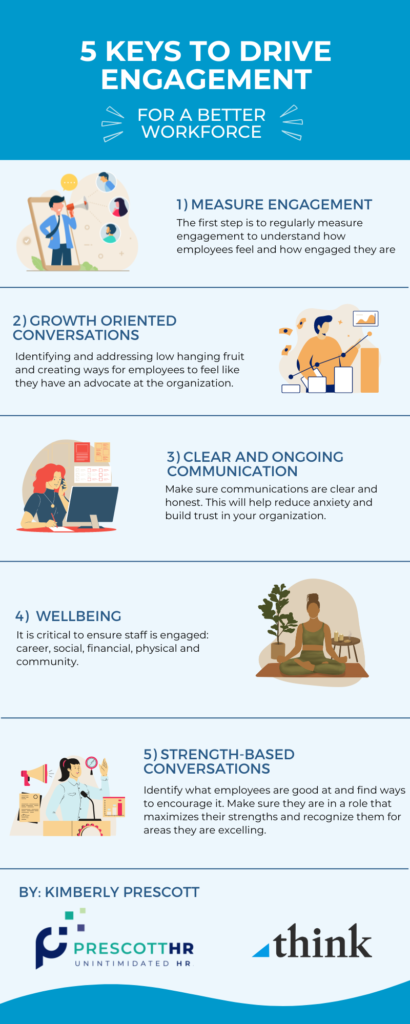5 Keys to Drive Employee Engagement

A top strategy for companies tackling the challenges of prolific job hopping, is implementing employee engagement tactics in the workplace.
Kimberly Prescott, President of Prescott HR who helps clients align people strategies with business strategies, provided five keys that drive staff engagement. She stressed that staff engagement at work is critical to retaining top talent and drives better business outcomes.
“Employment engagement is how your team shows up at work, the ideal workplace cares for its employees and uses engagement as a catalyst to improve business outcomes,” Prescott said. “Employees make decisions every day that impact your business. If they aren’t engaged, what kind of decisions do they make? How does that impact your business?”
Kimberly shared 5 key practices to implement in an effort to drive employee engagement.
Measure Employee Engagement
The first step is to regularly measure engagement to understand how employees feel and how engaged they are. Prescott recommends starting with a regular survey that includes these 12 true/false statements.
- I know what is expected of me at work.
- I have the materials and equipment to do my job.
- I have the opportunity to do what I do best every day.
- In the last 7 days I have received affirmation or praise for my work.
- My supervisor or someone seems to care about me as a person.
- Someone at work provides career development mentoring.
- At work, my opinions seem to count.
- The mission and purpose of my company makes me feel my job is important.
- My peers at the company are committed to doing quality work and everyone is held to the same standards.
- I have a best friend at work.
- In the last six months, someone talked to me about my progress.
- In the last year, I’ve had the opportunity to learn and grow at work.
Growth Oriented Conversations
Once you have feedback, it is critical to use the data to inform the company’s engagement strategies. Prescott suggests identifying and addressing low hanging fruit and creating ways for employees to feel like they have an advocate at the organization.
Clear and Ongoing Communication
This is critical because when people feel like they don’t know what is going on, it causes anxiety that prevents them from being productive. Safety and trust are also critical for clear, honest communication.
Wellbeing
Prescott identified five areas of wellbeing that are critical to ensure staff is engaged: career, social, financial, physical and community. If employees are dissatisfied in any of these areas, they will be distracted and less likely to fully engage. She also warned that, just because an employee is engaged, it doesn’t mean they are well holistically.
Strength-based Conversations
Identify what employees are good at and find ways to encourage it. Prescott says it is counter intuitive, but managers should spend more time with those who are excelling and less time with those who are struggling. Make sure they are in a role that maximizes their strengths and recognize them for areas they are excelling.
Making engagement front and center will improve business outcomes and it will also help build diversity in the company.
In this clip from Think’s Innovate mini-event, Prescott talks about the challenges and opportunities facing companies looking to foster diversity and inclusion. She says the key is to find an advocate for new hires so they feel included and represented even if they are not in the room.
Prescott clip: https://youtu.be/wBauzdzDsSg?t=1475
